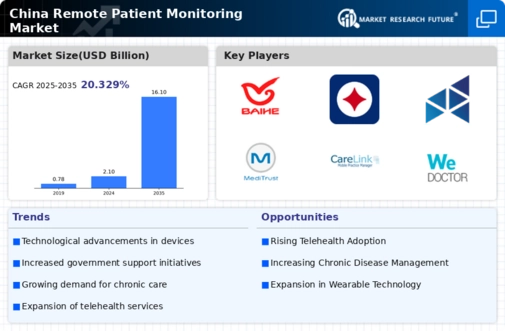Government Initiatives and Funding
The Chinese government is actively promoting the adoption of remote patient-monitoring technologies through various initiatives and funding programs. In recent years, substantial investments have been allocated to enhance healthcare infrastructure, particularly in rural areas where access to medical facilities is limited. The government aims to improve healthcare delivery by encouraging the integration of digital health solutions. Reports indicate that funding for telehealth and remote monitoring projects has increased by over 40% in the last two years. This financial support is expected to bolster the remote patient-monitoring market, facilitating the development and deployment of innovative solutions that cater to the diverse needs of the population.
Shift Towards Preventive Healthcare
There is a growing emphasis on preventive healthcare in China, which is significantly impacting the remote patient-monitoring market. As healthcare stakeholders recognize the importance of early detection and intervention, remote monitoring solutions are being adopted to facilitate proactive health management. This shift is reflected in the increasing number of health awareness campaigns and educational programs aimed at promoting healthy lifestyles. By 2025, it is anticipated that the market for preventive health services will expand by approximately 25%. The remote patient-monitoring market stands to gain from this trend, as individuals seek tools that empower them to take charge of their health and prevent potential health issues.
Aging Population and Healthcare Needs
China's demographic shift towards an aging population is significantly influencing the remote patient-monitoring market. By 2025, it is projected that over 20% of the population will be aged 60 and above, leading to a higher demand for healthcare services tailored to elderly patients. This demographic trend necessitates the implementation of remote monitoring systems that can provide continuous health assessments and timely interventions. The remote patient-monitoring market is likely to benefit from this shift, as healthcare providers seek to offer personalized care solutions that enhance the quality of life for older adults. The ability to monitor vital signs and health metrics remotely can lead to improved health outcomes and reduced healthcare costs.
Technological Integration in Healthcare
The integration of advanced technologies such as artificial intelligence (AI) and the Internet of Things (IoT) is transforming the remote patient-monitoring market in China. These technologies enable healthcare providers to collect and analyze vast amounts of patient data, facilitating more accurate diagnoses and personalized treatment plans. As of 2025, it is estimated that the adoption of AI in healthcare could increase efficiency by up to 30%. This technological evolution is likely to enhance the capabilities of remote monitoring devices, making them more effective in managing patient health. Consequently, the remote patient-monitoring market is poised for growth as healthcare systems increasingly leverage these innovations to improve patient care.
Rising Demand for Chronic Disease Management
The remote patient-monitoring market in China is experiencing a notable surge in demand driven by the increasing prevalence of chronic diseases such as diabetes and hypertension. As of 2025, approximately 300 million individuals in China are living with chronic conditions, necessitating continuous monitoring and management. This trend is compelling healthcare providers to adopt remote monitoring solutions to enhance patient outcomes and reduce hospital visits. The integration of advanced technologies in remote monitoring devices allows for real-time data collection and analysis, which is crucial for timely interventions. Consequently, the remote patient-monitoring market is likely to expand significantly as healthcare systems strive to improve chronic disease management and patient care efficiency.



















Leave a Comment